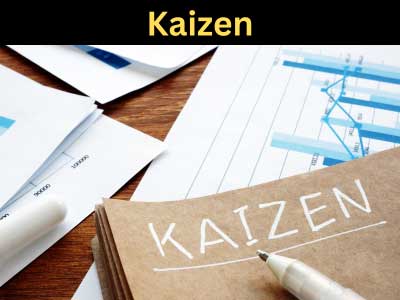Key Takeaway
Kaizen tools are essential for driving continuous improvement in manufacturing. Tools like the 5 Whys Analysis identify the root cause of problems by asking “why” multiple times, while the Fishbone Diagram (Ishikawa) visualizes potential causes of issues. The PDCA Cycle (Plan, Do, Check, Act) is a structured problem-solving method, and Gemba Walks involve managers observing work processes firsthand to identify inefficiencies. These tools help businesses uncover inefficiencies, reduce waste, and foster a culture of ongoing improvement, ensuring better productivity and overall performance.
Introduction to Kaizen Tools in Manufacturing
In Lean manufacturing, Kaizen tools are vital for fostering continuous improvement. These tools provide the framework needed to assess and optimize every aspect of the production process. Whether it’s eliminating waste, improving efficiency, or enhancing workplace organization, Kaizen tools guide teams in making small, manageable improvements that accumulate into significant results over time.
The beauty of Kaizen tools lies in their simplicity and adaptability. They can be applied in any manufacturing environment, from small-scale operations to large, complex production systems. By using these tools consistently, organizations can ensure that continuous improvement becomes ingrained in their culture.
For newly joined engineers, learning how to implement these tools effectively is key to mastering Lean principles. Whether it’s 5S for organizing the workspace or Value Stream Mapping for visualizing workflows, Kaizen tools are foundational to driving sustainable improvements in manufacturing.

5S as a Kaizen Tool for Workplace Organization
One of the most fundamental Kaizen tools is 5S, a method for workplace organization. The 5S system consists of five steps: Sort, Set in order, Shine, Standardize, and Sustain. These steps focus on creating a clean, organized, and efficient work environment, which is essential for improving productivity and reducing waste.
Sort: Eliminate unnecessary items from the workspace.
Set in order: Arrange tools and materials in a logical, accessible way.
Shine: Keep the workspace clean and well-maintained.
Standardize: Develop consistent procedures to maintain organization.
Sustain: Ensure these practices become routine and part of the company culture.
By implementing 5S, companies can reduce clutter, improve workflow, and enhance overall efficiency. For new engineers, mastering the 5S method is crucial for understanding how a well-organized workplace can dramatically improve performance. A clean, well-organized environment is also safer, leading to fewer accidents and errors.
Value Stream Mapping in Kaizen
Value Stream Mapping (VSM) is another essential tool in Kaizen, used to visualize and analyze the entire production process. VSM helps identify inefficiencies, bottlenecks, and areas where waste occurs. By mapping out the flow of materials and information through each step of the process, engineers can pinpoint non-value-adding activities and focus on streamlining operations.
The goal of Value Stream Mapping is to create a more efficient, waste-free production process. It allows teams to see the big picture and understand how each part of the system interacts. Once inefficiencies are identified, teams can implement targeted changes to reduce lead times, improve flow, and eliminate unnecessary steps.
For new engineers, learning how to use Value Stream Mapping effectively is essential for process optimization. It provides a structured way to assess processes, enabling teams to make data-driven decisions that enhance both efficiency and quality.
Standard Work as a Kaizen Tool
Standard Work is a crucial Kaizen tool that focuses on establishing a consistent and repeatable way of performing tasks. In Lean manufacturing, standardizing work ensures that best practices are followed, reducing variation and improving overall efficiency. By documenting the most efficient way to complete a task, Standard Work creates a baseline for improvement.
Standard Work involves breaking down tasks into steps and assigning specific timeframes to each activity. This not only improves efficiency but also makes it easier to identify areas where further improvements can be made. When implemented correctly, Standard Work helps maintain quality and consistency while providing a framework for future Kaizen initiatives.
For engineers, understanding Standard Work is critical for maintaining efficiency and consistency on the production floor. It ensures that tasks are completed in the most effective way, reducing errors, minimizing waste, and setting the stage for continuous improvement.
Root Cause Analysis in the Kaizen Framework
Root Cause Analysis is a powerful Kaizen tool used to identify the underlying causes of problems or inefficiencies. The idea is to go beyond surface-level issues and address the true source of a problem, ensuring that it doesn’t recur. One of the most popular methods for Root Cause Analysis in Kaizen is the 5 Whys technique, where teams ask “Why?” repeatedly to drill down to the root cause.
For example, if a machine breaks down frequently, instead of just repairing it, the 5 Whys method helps uncover why the breakdown occurs in the first place—whether it’s due to poor maintenance, operator error, or a deeper systemic issue.
By addressing the root cause, teams can implement solutions that prevent the problem from happening again, leading to long-term improvements in efficiency and productivity. For new engineers, mastering Root Cause Analysis is crucial for solving problems effectively and ensuring that improvements are sustainable.
Conclusion
The power of Kaizen tools lies in their ability to drive continuous improvement across all areas of manufacturing. From organizing the workspace with 5S to identifying inefficiencies through Value Stream Mapping, these tools provide the structure needed for companies to optimize their processes and reduce waste. Tools like Standard Work and Root Cause Analysis help ensure that improvements are not only implemented but sustained over time.
For new engineers, understanding and using Kaizen tools effectively is essential for fostering a culture of continuous improvement. These tools empower teams to identify opportunities for improvement, implement changes quickly, and measure their impact, ensuring that the organization remains agile, efficient, and competitive in today’s fast-paced manufacturing environment.
